The difference between precipitation and agglutination reaction is primarily due to the factors like the size of the antigen, solubility of antigen, and the reaction’s sensitivity. Both methods are prevalently employed to detect antigens and antibodies.
- Size of antigen: The size of the antigen in precipitation reaction is larger than the agglutination reaction.
- The solubility of antigen: In a precipitation reaction, the antigen is in soluble form whereas, in an agglutination reaction, the antigen is in sedimented form.
- The sensitivity of reaction: Agglutination reaction is comparatively more sensitive than the precipitation reaction.
The formation of lattices or cross-linkages is an identifying feature of the precipitation reaction, whereas clump formation indicates a positive result for agglutination reaction. Here, you will get to know the comparative study between the precipitation and agglutination reaction along with the definition, standard curve preparation for lattice formation and some similarities.
Content: Precipitation Vs Agglutination Reaction
- Comparison Chart
- Definition
- Standard Curve for Lattice Formation
- Key Differences
- Similarities
- Conclusion
Comparison Chart
| Properties | Precipitation reaction | Agglutination reaction |
|---|---|---|
| Definition | It is the antigen antibody reaction where the antibody reacts with the soluble antigen to form precipitin | It is the antigen antibody reaction where the antibody reacts with the soluble antigen to form agglutinin |
| Size of an antigen | larger | Comparatively smaller |
| Solubility of antigen | Soluble form | Sedimented form |
| Sensitivity | Less sensitive | More sensitive |
| Media used | Either liquid or gel matrix | Does not require |
| Types | Precipitation in solution, precipitation in agar by diffusion and electrophoresis are the three common types of precipitation reaction | Active and passive agglutination |
| Matrix | Precipitation reaction can be performed on glass slides, petri plates and test tubes | Agglutination reaction can be performed on microtitre plate, glass slides and test tubes |
| Resulted compound | Precipitins | Agglutinins |
| Formation of resulted compound | Either found as suspension or sink to the bottom | The end product sinks to the bottom |
| Appearance of end product | The end product exists as a large, insoluble mass of visible precipitate | The end product exists as a large visible aggregates |
Definition of Precipitation Reaction
The term precipitation merely refers to the visible lattice formation between the reacted particles in the liquid suspension. It results in the formation of cross-linkages visible in the form of an insoluble mass called precipitate. Thus, the precipitation reaction depends upon the principle of lattice formation.
In terms of biology, precipitation reaction is defined as the immunological reaction that causes in the appearance of visible precipitate due to the cross-linkage between antigen and antibody. The resulting compound in precipitation reaction appears as a precipitate by the reaction of antibodies (Precipitin) with the respective antigens.
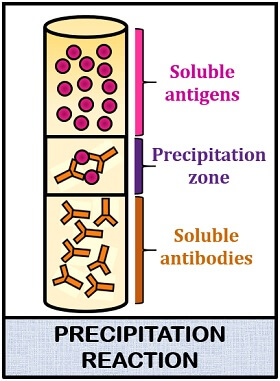
Definition of Agglutination Reaction
The term agglutination purely refers to the aggregation or clumping of the particles in the given suspension. It results in the formation of clumped solid mass, which is called aggregate. Hence, the agglutination reaction depends upon the principle of aggregation.
In terms of biology, It is defined as the immunological reaction that causes in the formation of the visible aggregated due to clumping between antigen and antibody. An immunocomplex is formed by the binding of antibodies (agglutinins) to the specific antigenic sites. The end product appears as a large aggregated mass.
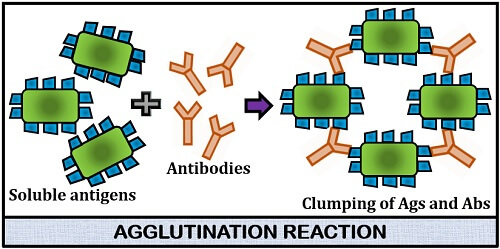
Standard Curve for Lattice Formation
There are three zones in both precipitation and agglutination, namely pro-zone, post-zone, and zone of equivalence.
Pro-zone: It forms in case of an excess antibody concentration. Pro-zone gives a negative result for both precipitation as well as agglutination reaction. This does not form the immunocomplex or antigen-antibody complex.
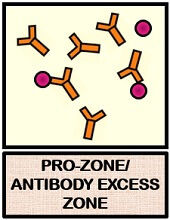
Zone of equivalence: It forms when the concentration and ratio of both antigen and antibody are at equilibrium. Zone of equivalence gives a positive result in the formation of an immunocomplex via lattice formation.
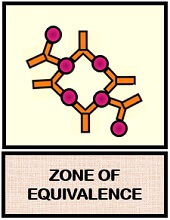
Post-zone: It forms in case of an excess antigen concentration. Post-zone also gives a negative result for both the reactions and does not form an immunocomplex.
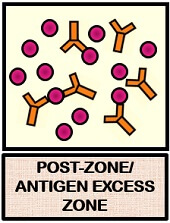
There is a standard curve for the lattice formation where at the zone of equivalence, the precipitation and agglutination reaction occurs. To prepare the standard curve, one reactant is kept constant (Antibody) and the other reactant (Antigen) is kept on increasing. Therefore, by increasing the concentration of antigens and keeping the constant volume of antibody, three zones will form, shown in the diagram below.

Key Differences Between Precipitation and Agglutination Reaction
- A precipitation reaction is a serological assay, in which the antibodies form a precipitate by reacting with specific antigens to form an end product (precipitate) as an insoluble visible mass. Oppositely, an agglutination reaction is a serological assay, in which the reacting molecules, i.e. antigens and antibodies form an end product (aggregate) as visible aggregates.
- The size of antigen in precipitation reaction is larger than the agglutination reaction.
- The antigen in precipitation reaction is in soluble form, whereas sedimented form in agglutination reaction.
- The sensitivity of agglutination reaction is more than the precipitation reaction.
- In a precipitation reaction, both liquid and gel media can be used, whereas agglutination reaction does not require media support.
- A precipitation reaction is mainly of three types namely precipitation in solution (Includes ring and flocculation test), precipitation by diffusion (Includes Oudin, Ookley Fulthorpe, Radial and Ouchterlony immunodiffusion) and precipitation by electrophoresis (Includes rocket and counter-immunoelectrophoresis). But, an agglutination reaction is mainly of two types, namely active and passive types.
- Precipitin is the resulting compound of precipitation reaction that either exists as suspension or at the bottom. In contrast, agglutinins are the resulting compounds of agglutination reaction that exists at the bottom.
- The end product in precipitation reaction appears as a large, insoluble mass of visible precipitate. But, in an agglutination reaction, the end product appears as a large mass of visible aggregates.
Similarities
- Both precipitation and agglutination reaction are the two most common serological assays.
- Both can be used for the quantitative study of antigen and antibody.
- Agglutination and precipitation reaction requires both the reactants, i.e. antigen and antibody to form an immunocomplex or lattice.
Conclusion
Therefore, precipitation and agglutination reactions are the serological assays, which requires both antigens and antibodies as the reacting particles. The aggregation or cross-linkage between the antigens and antibodies result in the formation of immunocomplex or lattice. For the reaction to occur, the ratio of antigen and antibody must be equal. It there is any change in the ratio of either antigen or antibody, the formation of a lattice will not occur.